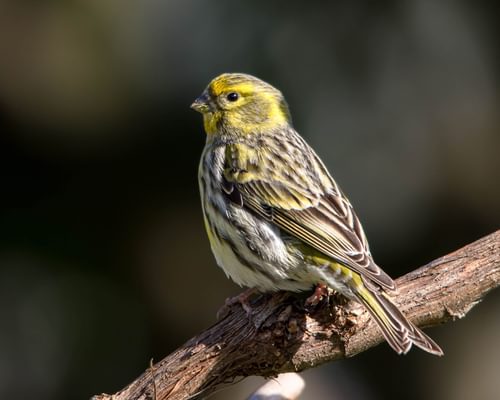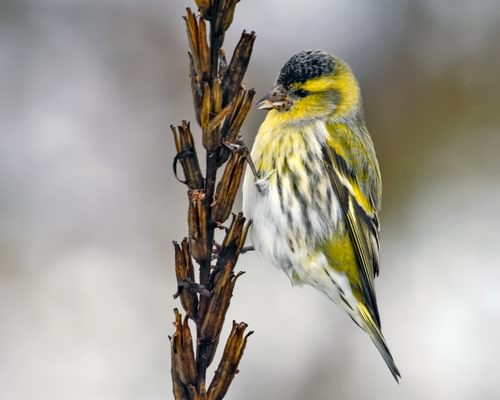Yellowhammer
Least ConcernEmberiza citrinella
Visual Identification
Appearance
The Yellowhammer is a striking small bird known for its bright yellow head and underparts in males. Its back and wings are chestnut-brown with dark streaks, creating a rustic appearance. The tail is dark with white outer feathers.
Females are less vibrant, with a paler yellow wash and more streaking on the head and breast. Juveniles resemble females but with even less yellow colouration.
Size
Length
15.5cm to 17cm
Wingspan
23cm to 29.5cm
Weight
20g to 36g
Habitat and Distribution
Habitats
Woodland
Garden
Wetland
Coastal
Urban
Farmland
Grassland
Desert
Tundra
Rainforest
Mountain
Savanna
Distribution
Yellowhammers inhabit open countryside with scattered bushes and trees. They are commonly found in farmland, heathland edges, and open woodland. Their range extends across much of Europe and into western Asia.
In the UK, they are widespread but have experienced declines. They are year-round residents in much of their range, with some northern populations migrating south for winter.
There have been successful introductions to Australia and New Zealand.
Elevation Range
Up to 2,000 meters
Climate zones
Temperate, Subarctic
Distribution Map
This map gives you a rough idea of where you might spot a Yellowhammer. The coloured areas show countries where these birds have been seen.
A few things to keep in mind:
- Birds might not be everywhere in the coloured areas, for example, they may be present around the coast of that country
- Where birds live can change with seasons and available food
- This map is quite simple - it doesn't show exact locations
We're working on making our maps even better! Soon, we hope to show you:
- More detailed maps for bigger countries, including state and region
- How birds move around during different seasons
Distribution by Region
Behaviour and Ecology
Bird Attributes
This feature is in beta. We'd love your feedback to improve it!
Share your thoughtsBird Attributes Explained
Our bird attributes system rates various aspects of a bird's capabilities on a scale of 0-100, based on data from field observations, scientific studies, and expert knowledge.
Attribute Categories:
- Agility: Manoeuvrability, speed, and grace in flight or movement.
- Strength: Physical power, often correlating with size and hunting abilities.
- Adaptability: Ability to thrive in various environments or changing conditions.
- Aggressiveness: Territorial behaviour and assertiveness, particularly during breeding seasons.
- Endurance: Stamina, often seen in migration patterns or foraging behaviours.
Understanding the Ratings:
- 0-20: Very Low
- 21-40: Low
- 41-60: Average
- 61-80: High
- 81-100: Very High
Remember, these attributes are relative to other bird species and don't necessarily indicate superiority.
Hover over the icon next to each attribute for more information.
Tap the icon next to each attribute for more information.
Agility
Reflects the bird's manoeuvrability, speed, and grace in flight or movement.
The Yellowhammer displays moderate agility, being adept at perching on hedges and low branches, as well as hopping and running on the ground for foraging. Their ability to engage in aerial chases during breeding season suggests reasonable manoeuvrability in flight.
Strength
Indicates the bird's physical power, often correlating with size and hunting abilities.
As a small passerine bird weighing between 20-36 grams, the Yellowhammer has limited strength. Their primary activities of foraging and singing don't require significant physical power, though they can defend territories and construct nests.
Adaptability
Represents the bird's ability to thrive in various environments or changing conditions.
Yellowhammers show good adaptability, inhabiting various open habitats from farmland to heathland edges. Their ability to adjust their diet seasonally, switching from seeds to insects during breeding, and their partial migratory behaviour in some populations, demonstrate flexibility.
Aggressiveness
Measures the bird's territorial behaviour and assertiveness, particularly during breeding seasons.
While generally not highly aggressive, male Yellowhammers become territorial during breeding season, engaging in aerial chases to defend their areas. However, they're not known for extreme aggression compared to other bird species.
Endurance
Reflects the bird's stamina, often seen in migration patterns or foraging behaviours.
Yellowhammers display moderate endurance. They can produce up to three broods in a single breeding season, which requires sustained effort. Their ability to survive in various climates and their partial migratory nature in some populations suggest reasonable stamina, though they're not known for exceptional long-distance flights.
Diet
Yellowhammers primarily feed on seeds, especially those of grasses and cereals. During the breeding season, they supplement their diet with insects and spiders, which are crucial for feeding their young. They forage on the ground, often in stubble fields or along field margins.
Behaviour
Yellowhammers are often seen perched on top of hedges or low branches, singing their distinctive song. They forage on the ground in small flocks during winter, hopping and running to find seeds.
During the breeding season, males become territorial and engage in aerial chases to defend their areas.
Vocalisation
The Yellowhammer's song is one of the most recognisable in the countryside, often described as sounding like 'a little bit of bread and no cheese'. The rhythm starts slow and ends with a quick, high-pitched note. Their call is a sharp 'zit' or a softer 'twick' when in flight.
Nesting & Breeding
Breeding season for Yellowhammers typically begins in April and can last until August. Males establish territories and attract females with their distinctive song.
Nests are built on or near the ground, often at the base of a hedge or in tall grass. The female constructs a cup-shaped nest using grass and moss, lined with fine grass and hair.
Females lay 3-5 eggs, which are pale purple-white with dark scribble-like markings. Incubation lasts about 12-14 days, and chicks fledge after 11-13 days.
Lifespan
The Yellowhammer typically lives for 3 to 6 years, with a maximum recorded lifespan of 13.2 years.
Like all birds, lifespan can be affected by factors including predation, habitat quality, disease, and access to food sources.
Conservation and Status
Global Conservation Status
While listed as Least Concern globally, Yellowhammer populations have declined significantly in parts of Europe, including the UK. This decline is largely attributed to changes in farming practices, particularly the loss of winter stubble fields and hedgerows.
Conservation efforts focus on promoting wildlife-friendly farming methods.
Birdwatching Tips
- Listen for the male's distinctive 'little bit of bread and no cheese' song
- Look for bright yellow heads in hedgerows and field edges
- Observe their ground-feeding behaviour in open fields
- In the UK, participate in the RSPB's annual Big Garden Birdwatch to help monitor populations
Additional Information
Quick Facts
Other names:
Yellow Bunting
Family:
EmberizidaePredators
Did You Know?
- Yellowhammers inspired Beethoven's 5th Symphony opening motif.
- They can produce up to three broods in a single breeding season.
- In New Zealand, introduced Yellowhammers are considered agricultural pests.
Was this bird profile helpful?
Your feedback helps us improve our content
Thanks for your feedback!
Your input helps us improve our content.
Community Experience
Community Ratings
1 rating from birders
Latest Community Reviews
Judith Campbell
Community Reviews
Create Your Free Account Welcome Back!
Join our community to rate birds and share your experiences. Creating an account is completely free and only takes a minute. Sign in to your account to rate birds and share your experiences with our community.
Your information is secure and will never be shared.
By creating an account, you agree to our Privacy Policy.
Similar Birds
References
- 2 3
website: BirdLife International. 2016. Emberiza citrinella. The IUCN Red List of Threatened Species 2016: e.T22720878A89289181.
View source - 4
report, 2015: EBCC
- 1
website, 2010: Fransson et al., EURING list of longevity records for European birds
View source





